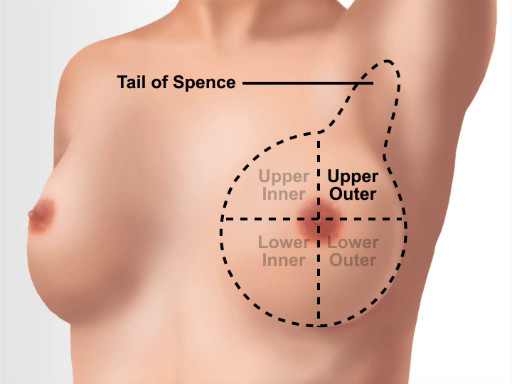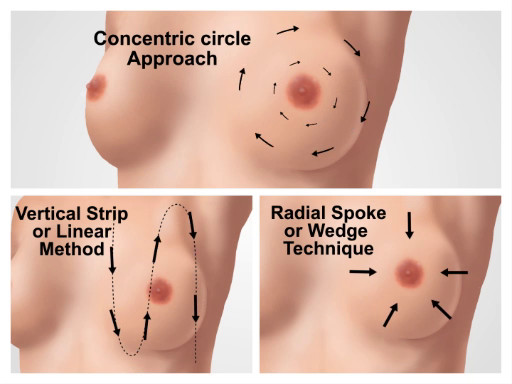Exploración mamaria
Visión general
Fuente:
Alexandra Duncan, GTA, Praxis clínica, New Haven, CT
Cocinero de Tiffany, GTA, Praxis clínica, New Haven, CT
Jaideep S. Talwalkar, MD, medicina interna y Pediatría, Facultad de medicina de Yale, New Haven, CT
Exámenes de los senos son una parte clave de un examen ginecológico anual y son importantes para todos los pacientes, sin importar su sexo o género de expresión. Uno de cada 8 mujeres será diagnosticada con cáncer de mama; cáncer de mama masculino, aunque menos común, tiene una incidencia de por vida de 1 en 1000.
Exámenes de las mamas pueden sentir invasivos a los pacientes, por lo que es importante hacer todo lo posible para que los pacientes se sienta cómodo y poder, más que vulnerables. Los examinadores deben ser conscientes de lo que están comunicando, tanto verbal como no verbal y dan a sus pacientes control siempre que sea posible (por ejemplo, siempre lo que les permite retirar sus vestidos). Los examinadores pueden optar por utilizar acompañantes de los pacientes (así como sus propios) comodidad. Algunas instituciones requieren el uso de chaperonas.
Si bien siempre es importante evitar el lenguaje excesivamente clínico, ciertas palabras coloquiales pueden cruzar la línea de cuidado para excesivamente íntimo en este examen. Es útil evitar las palabras "touch" y "siento" en este examen, como esta lengua puede sentir sexualizada. En su lugar, utilice palabras como "evaluar", "check", o "examinar".
Además, la mejor práctica dicta evitar asunciones sobre el género de los pacientes, como pacientes con anatomía femenina se pueden identificar como otro género (transgénero, genderqueer, etcetera.). Este video representa el acercamiento a los pacientes cuya historia no ha revelado ninguna quejas específicas o factores de riesgo relacionados con la salud de los senos.
Para evitar la falta de resultados potenciales, el examen de mama se debe realizar en un enfoque sistemático y consisten en tres componentes principales: la inspección visual de la palpación de tejido mamario, tejido mamario y la palpación de los ganglios linfáticos.
El tejido mamario se extiende desde justo debajo de la clavícula a alrededor de la quinta costilla (o la línea del sujetador). Lateralmente, se extiende desde la línea midaxillary hasta la frontera esternal. Se ve la mama en cuatro cuadrantes; el cuadrante superior externo tiene el tejido más y es la ubicación de muchos de los ganglios linfáticos, y la cola de Spence (o cola axilar) se extiende hasta el borde de la axila, donde une a la pared torácica (figura 1).

Figura 1. Puntos anatómicos de la mama.
Procedimiento
1. preparación
- Antes de comenzar los exámenes de mama, establecer una expectativa de confort, y pida al paciente para comunicar dudas e inquietudes durante la visita. Por ejemplo, decir algo como, "¿ha tenido un examen similar antes? ¿Cómo fue esa experiencia para usted? Espero que esto sea un examen cómodo. Si hay algo que pueda hacer para hacerlo más cómodo para usted, hágamelo saber y voy a hacer cualquier ajuste que pueda. Usted puede hacer me preguntas en cualquier momento."
- Límpiese las manos.
Aplicación y resumen
Este video cubre cómo realizar el examen clínico de mama y cómo visualmente inspeccionar y examinar el tejido mamario y los ganglios linfáticos asociados. Antes de inicia el examen de mama, el examinador debe establecer la expectativa de que el paciente puede comunicar dudas e inquietudes durante la visita. El paciente debe pedir a quitar el vestido sólo cuando sea necesario y recuerda cuando al levantar el vestido durante el examen. Esto reduce al mínimo los sentimientos de vulnerabilidad.
Log in or to access full content. Learn more about your institution’s access to JoVE content here
Saltar a...
Vídeos de esta colección:

Now Playing
Exploración mamaria
Physical Examinations II
87.4K Vistas

Examen de la vista
Physical Examinations II
77.0K Vistas

Oftalmoscopía
Physical Examinations II
67.7K Vistas

Examen de los oídos
Physical Examinations II
54.9K Vistas

Exploración de la nariz, senos paranasales, cavidad oral y faringe
Physical Examinations II
65.6K Vistas

Exploración de la tiroides
Physical Examinations II
104.8K Vistas

Exploración de ganglios linfáticos
Physical Examinations II
386.8K Vistas

Exploración abdominal I: Inspección y auscultación
Physical Examinations II
202.5K Vistas

Exploración abdominal II: Percusión
Physical Examinations II
248.0K Vistas

Exploración abdominal III: Palpación
Physical Examinations II
138.5K Vistas

Exploración abdominal IV: Evaluación de dolor abdominal agudo
Physical Examinations II
67.2K Vistas

Tacto rectal masculino
Physical Examinations II
114.3K Vistas

Exploración pélvica I: Evaluación de los genitales externos
Physical Examinations II
306.4K Vistas

Exploración pélvica II: Examen con espéculo
Physical Examinations II
150.2K Vistas

Exploración pélvica III: Bimanual y examen rectovaginal
Physical Examinations II
147.5K Vistas
ACERCA DE JoVE
Copyright © 2025 MyJoVE Corporation. Todos los derechos reservados

